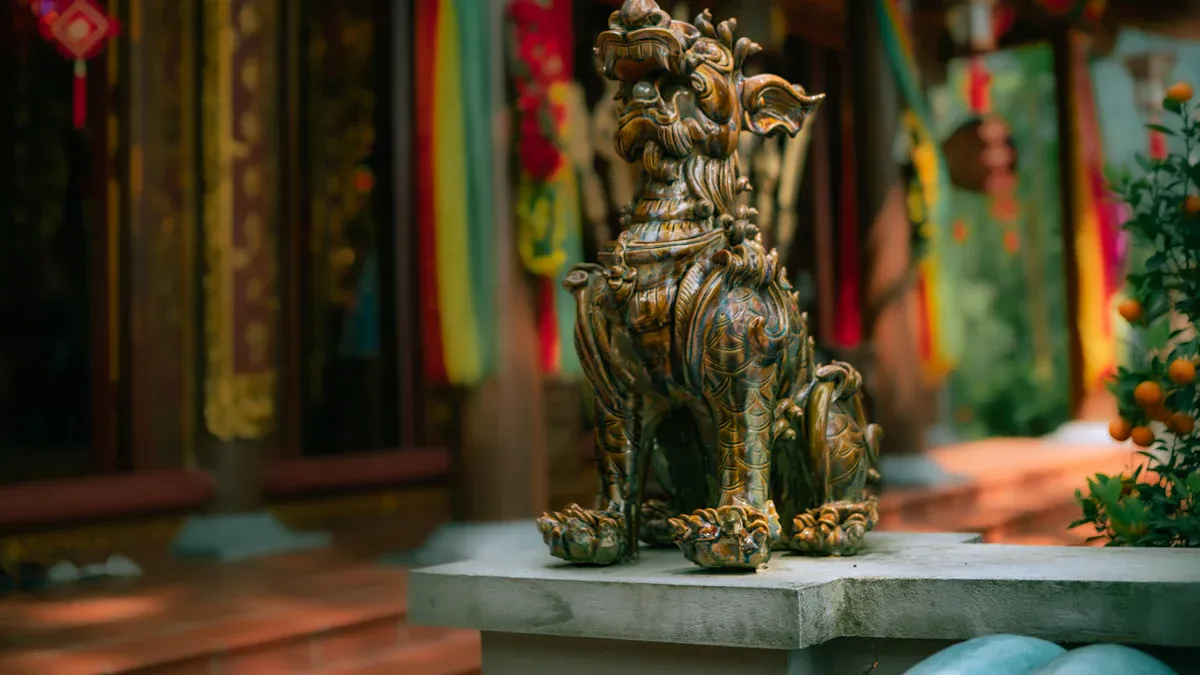
The kirin is a famous creature in East Asian myths, often prompting the question, what dose kirin mean? It is seen as a sign of peace, wisdom, safety, and good luck. Experts in Japan, China, and Korea have studied the kirin for a long time, highlighting its impact on language and culture. The kirin appears in many stories, sometimes judging people or signaling the birth of a king. People often ask, what dose kirin mean? In Japan and Korea, kirin is also the word for giraffe, a connection that began when a real giraffe arrived in China during the Ming Dynasty. The kirin is believed to have magical powers like walking on water or flying, making it a strong symbol of hope and goodness.
Key Takeaways
The kirin is a mythical creature. It stands for peace, wisdom, protection, and good luck in East Asian cultures. It looks special because it mixes parts of animals like deer, lion, and dragon. The kirin is known for being gentle. In stories, the kirin shows up when there are fair rulers and peaceful times. It gives people hope and makes them think about fairness. In Japan, kirin is also the word for giraffe. This connects old myths with real animals and shows how culture changes. The kirin is a holy animal. It stands for purity, justice, and spiritual power. People often see it at temples and festivals. People use kirin symbols to protect themselves and bring good luck. They also use it to teach values like kindness and honesty. The kirin is found in language, art, books, and modern media. This helps keep its story alive today. Kirin festivals and daily uses show how this symbol links old traditions with modern life. It inspires many people.
What Does Kirin Mean
Definition
The kirin, also known as qilin in Chinese, is a mythical creature found in many East Asian cultures. People often ask, what dose kirin mean? Scholars describe the kirin as a chimerical animal with features from several real animals. It may have the body of a deer, the head of a lion, green scales, and a long curved horn. Some call it the Chinese unicorn, but it looks different from the Western unicorn. The kirin appears in stories from China, Japan, Korea, Thailand, and Vietnam. In Japan, the word kirin can also mean giraffe, showing how the creature’s image changed over time. The kirin stands as one of the four sacred beasts in China, along with the dragon, phoenix, and turtle. Its presence in ancient texts and legends shows its importance in East Asian culture.
The kirin is so gentle that legends say it can walk on grass without bending a single blade. This detail highlights its peaceful nature and its role as a guardian of good.
Symbolism
People often wonder, what dose kirin mean in stories and art? The kirin carries deep symbolic meaning in East Asian culture. It is a symbol of good fortune, wisdom, and purity. Many legends describe the kirin as a symbol of protection and a symbol of peace. The creature often appears before the birth or death of great leaders, acting as a sign of just and wise rule. In some tales, the kirin brings babies to deserving parents, much like the stork in European stories. The qilin’s image stands for moral values, prophecy, and the ability to tell right from wrong. Its gentle nature and magical powers make it a symbol of wisdom and a symbol of good fortune.
The kirin is a symbol of good fortune and longevity, with some stories saying it can live for 2,000 years.
The qilin is a symbol of protection, guarding the righteous and bringing peace.
The creature’s appearance signals the arrival of a wise ruler or a time of harmony.
Sacred Qualities
What dose kirin mean when people call it a sacred beast? The kirin holds a special place as a sacred animal in East Asian culture. Ancient texts describe it as pure, benevolent, and a sign of just rule. The kirin only appears during the reign of wise and kind leaders, showing its connection to peace and good government. In Japanese history, the Nihon Shoki tells of Emperor Yūryaku seeing a kirin, which people took as a sign of his fair rule. The kirin’s breath or presence is said to heal and protect, adding to its sacred status. Its body combines parts of deer, ox, fish, and dragon, showing its divine origin. The qilin stands for justice, nobility, and the protection of the righteous. Many see it as a guardian of good and a sacred beast that brings spiritual energy.
The kirin’s gentle steps and healing powers remind people of its sacred role as a symbol of purity and a sign of good fortune.
What dose kirin mean in the end? It means more than just a mythical creature. The kirin is a symbol of wisdom, a symbol of protection, and a sacred beast that inspires hope and harmony in East Asian culture.
Kirin in Chinese Mythology
Origins
The kirin, also called qilin, is very old in Chinese stories. People wrote about it as early as the 5th century BC. Its story changed as Chinese beliefs changed too. The table below shows how the kirin’s story and look changed over time:
Time Period / Source |
Description |
|---|---|
5th century BC - Zuo Zhuan |
The qilin was first written about in Chinese stories. This shows it is very old. |
122 BC - Emperor Wu of Han |
Emperor Wu said he caught a real qilin. This made the creature important in Han times. |
Various historical and fictional works (e.g., Feng Shen Bang) |
The qilin kept showing up in books and stories. This means it stayed important in Chinese culture. |
Zhou Dynasty |
The qilin was the top mythical animal, even above the dragon and phoenix. This shows it was very special. |
Post-Qin Period |
The qilin became third place after the dragon and phoenix. This shows that ideas about myths changed. |
Ming Dynasty |
The qilin started to look more like a giraffe. This happened after people saw giraffes from Africa. |
Japanese Adaptation |
The kirin comes from the Chinese qilin. Sometimes it has wings or looks like a lion. This shows how the idea changed in other places. |
The kirin’s beginnings show it was a very important creature in China. Over many years, the qilin became a sign of good luck, wisdom, and safety.
Physical Traits
The kirin looks different from other magical animals. Old Chinese art and stories show the qilin with parts from many animals. It might have a deer’s body, an ox’s tail, and horse’s hooves. Its skin has scales, and it often has one long horn on its head. The horn is called the alicorn or silverhorn. It is grayish-white and grows from a special spot. The horn is strong and sharp, and it helps protect the kirin. The kirin’s feet have three toes with hard hooves, but the bottoms are soft for better walking. Some pictures show the qilin with a mane of fire or a glowing light, making it look magical.
Artists in China often draw the kirin with antlers, a long tail, and a kind face. The horn means purity, and the hooves show it eats plants and is peaceful. These things make the kirin a sign of safety and good luck in Chinese stories.
Role in Legends
The kirin is very important in Chinese stories and old books. In the 'Shan Hai Jing,' the qilin is a kind animal that brings peace and wealth. It is often shown with dragons and phoenixes, which means it is very special. When the qilin comes, it means a great leader or wise king will be born. Many stories say the kirin only comes when rulers are fair, so it stands for wisdom and safety.
Old records like the 'Records of the Grand Historian' tell about Emperor Wu of Han meeting a qilin. This shows the creature is linked to real history. The 'Gongyang Zhuan' says the qilin is pure and good, and it can tell if a ruler will rise or fall. In the Ming dynasty, the kirin was put on army clothes, showing it stood for goodness and luck. These stories show the qilin is a sign of peace, fairness, and wealth in Chinese culture.
Symbolic Values
The kirin is very important in Chinese myths. People think the kirin, or qilin, brings good luck and strong morals. In old stories, the qilin shows up when a wise leader is born. It also comes when a great ruler dies. This makes the kirin a sign of big changes and new starts in Chinese life.
Writers in old Chinese books, like the Zuo Zhuan, say the qilin brings blessings. The qilin stands for justice, kindness, and peace. When people see the kirin in art or stories, they think of honesty and fairness. The qilin never hurts living things. It walks so softly that it does not bend grass. This gentle way shows the kirin is a protector and brings harmony.
When the kirin appears, it means peace and good leaders are coming. Many people believe the qilin only shows up when rulers are wise and care for their people.
The qilin also means heaven supports a ruler. In Chinese myths, the kirin is a sign that heaven likes a leader. Emperor Wu of Han said he caught a live qilin. Some historians did not believe this story. Still, it shows people respected the kirin as a sign of power and virtue.
In China, the kirin is seen on clothes, art, and buildings. People use the qilin to show hope for peace and fairness. The kirin is linked to good luck and safety, so families and leaders like this symbol.
Here are some main symbolic values of the kirin and qilin:
Auspiciousness: The kirin brings luck and happy times.
Virtuous Leadership: The qilin comes for wise and fair rulers.
Peace and Harmony: The kirin stands for calm and gentle acts.
Protection: The qilin guards good people and keeps away evil.
Moral Example: The kirin reminds people to be honest and kind.
The kirin and qilin still inspire people in China today. Their stories teach about good leaders, kindness, and hope for a better world.
Kirin Japanese Culture
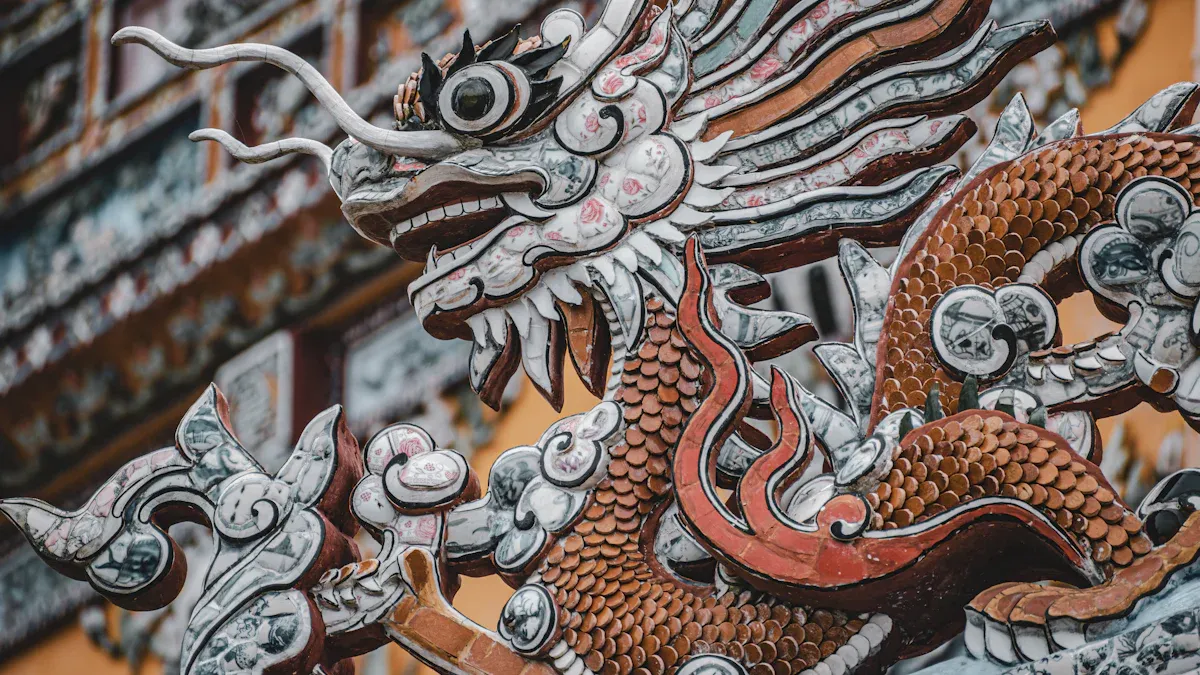
Introduction to Japan
The kirin came to Japan from China long ago. Japanese scholars read about the kirin in Chinese books. They brought these stories back to Japan. Over time, the kirin became important in Japanese beliefs. People thought the kirin had magical powers. Artists and writers made new stories about the kirin. The kirin started to look different in Japanese art. Many people believed the kirin could bring peace. They also thought it could protect the land. The kirin became a strong tradition in the Heian period. Temples and shrines sometimes showed the kirin as a guardian. The kirin became a symbol of hope for everyone in Japan.
Kirin Japanese Symbolism
The kirin stands for peace, wisdom, and protection. In Japan, the kirin appears when a wise ruler is born. It also comes when a time of harmony starts. People believe the kirin brings good luck. They think it keeps away evil. The kirin looks gentle and never hurts living things. Many families use the kirin as a sign of safety. The kirin also means honesty and justice. Teachers use the kirin to inspire students. The kirin teaches kids about kindness and respect. At festivals, people carry kirin masks or statues for luck. The kirin helps people remember the value of peace.
The kirin reminds everyone to be wise and careful. Many people in Japan see the kirin as a guide for good choices.
Kirin as Giraffe
The word kirin also means giraffe in Japan today. This started in the 1400s when a giraffe came to China. The Chinese called it qilin, and Japan used the word kirin. The Japanese language kept this meaning for giraffe. Now, kids at the zoo call the giraffe "kirin." The word kirin for giraffe shows how language changes. Some stories mix the magical kirin with the real giraffe. Artists sometimes draw the kirin with a long neck. The link between kirin and giraffe makes the word special. It connects old myths with the modern world. The word kirin now means both a magical and a real animal. This shows how Japanese culture changes and grows.
When people in Japan say "kirin," they might mean a magical beast or a tall zoo animal. The kirin story keeps inspiring new generations.
Artistic Depictions
Artists in Japan show the kirin in many ways. You can see the kirin in paintings, woodblock prints, and sculptures. It is also in festival decorations. Japanese artists use bright colors and thick lines to make the kirin easy to see. The kirin’s body sometimes looks like a deer. It can also have scales like a dragon or a mane like a lion. Many temples and shrines have kirin statues at their doors. These statues protect the temple and greet people who visit.
In old Japanese paintings, the kirin stands next to wise rulers or heroes. Artists use the kirin to show peace and smart thinking. Some scrolls from the Edo period show the kirin walking softly in clouds or forests. The kirin’s gentle steps and kind eyes show it is peaceful. Woodblock prints sometimes show the kirin with dragons or phoenixes. These pictures show that nature can be balanced and calm.
Japanese festivals also have the kirin. At some festivals, people carry big kirin floats in the streets. These floats are colorful and have lots of details. Kids and adults wear kirin masks and costumes. Music and dancing at the festival make the kirin feel alive. Many families think seeing the kirin at a festival brings good luck for the year.
The kirin is in Japanese crafts too. Pottery, lacquerware, and cloth often have kirin patterns. Some kimono have the kirin as a sign of safety. Sword guards called tsuba sometimes have small kirin pictures carved in them. These little details show how much people respect the kirin.
Today, Japanese culture still loves the kirin. Manga and anime artists draw the kirin in new ways. Some video games use the kirin as a strong creature or protector. You can even see the kirin in company logos and ads. The kirin’s image links old times with life in Japan today.
The kirin is still important in Japanese art and culture. It stands for peace, wisdom, and protection. Every generation finds new ways to honor the kirin in Japan.
Cultural Significance of Kirin
Peace and Justice
The kirin is a sign of peace and fairness in East Asia. Many people think the kirin shows up only when there is harmony. Old stories say the kirin comes when a wise ruler leads. This idea gives the kirin a special meaning. The kirin never hurts any living thing. It walks so softly that grass stays straight. This gentle way teaches people to be kind and fair.
Leaders in China and Japan used the kirin’s image to show they wanted justice. They put kirin statues at temples and government places. These statues reminded people to be honest and caring. The kirin’s meaning is tied to the idea that good leaders bring peace. Seeing the kirin in art and stories helps people remember to value justice.
The kirin’s soft steps show that real strength comes from being kind and fair.
Good Fortune
The kirin is also known for bringing good luck. Many families keep kirin pictures or statues at home. They believe the kirin keeps them safe and brings luck. In some places, people give kirin charms as gifts for new starts, like weddings or when a baby is born. The kirin’s special meaning makes it popular at big life events.
Here is a table that shows how people use the kirin for luck:
Occasion |
Kirin Symbol Used |
Meaning |
|---|---|---|
New Year |
Kirin decoration |
Wishing for luck |
Weddings |
Kirin charm |
Blessing for happiness |
Birth of a child |
Kirin statue |
Hope for protection |
Stories often say the kirin brings luck. People think seeing a kirin means something good will happen. The kirin’s sacred role makes it a strong sign of good fortune.
Inspiration and Morals
The kirin helps people learn about good values. Teachers tell kirin stories to teach kids about honesty, respect, and working hard. The kirin’s meaning in schools helps shape what young people believe. In legends, the kirin shows why truth and kindness matter.
Many schools and families see the kirin as a good example. They tell kids the kirin rewards those who act with honor. The kirin’s special nature makes it a trusted guide for making good choices. The kirin’s meaning is part of daily life and reminds everyone to do the right thing.
The kirin’s story is part of East Asian culture. It teaches lessons that last for many years.
The kirin’s meaning still helps people make fair and wise choices today.
Spiritual Energy
The kirin is a strong sign of spiritual energy in East Asia. People think the kirin brings a special power that helps make peace. This power also helps people get along. Many stories say the kirin can tell good from bad. When people see the kirin, they feel hope and comfort. The kirin’s presence means a place is safe or blessed.
In temples and shrines, kirin statues stand at the doors. Visitors see these statues and feel protected. The kirin’s image tells people to be kind and respectful. Some families keep small kirin figures at home. They believe the kirin brings calm and good energy to their lives.
The kirin’s energy links people to nature. Old stories say the kirin walks softly on grass. It never hurts any living thing. This gentle way shows the kirin respects all life. People learn from the kirin to care for the world. The kirin’s actions teach about balance and harmony.
Many people think the kirin knows when someone is pure. The kirin rewards those who are honest and good.
The kirin is part of important events too. At festivals, people carry kirin masks or statues. They hope the kirin will bless the event and bring luck. Some schools use the kirin as a symbol for students who work hard. The kirin’s energy inspires people to do their best.
Here is a table that shows how the kirin’s energy is seen in daily life:
Place |
Kirin’s Role |
|---|---|
Temples |
Guardian and protector |
Homes |
Bringer of peace and calm |
Festivals |
Source of luck and blessing |
Schools |
Model for good behavior |
The kirin’s meaning is more than just a myth. Today, many people still look to the kirin for help. The kirin’s energy helps people feel strong during hard times. It reminds everyone to stay hopeful and kind. The kirin keeps inspiring people to live with honesty and care for others.
Kirin in Language
Etymology
The word kirin comes from Chinese words. In China, people call it "qilin." When the idea went to Japan, the name changed to kirin. The first part, "ki," means "male." The second part, "rin," means "female." This shows the kirin has both male and female sides. Over time, kirin became a symbol for a magical animal in stories. People use gentle and wise words to talk about the kirin. In Korea, people say "girin" for the same creature. The way kirin spread shows how language can change. Kirin is also the word for giraffe in Japanese today. This started when people saw a giraffe and thought it looked like the kirin. The story of the word shows how language and culture are linked.
Pronunciation
People say kirin in different ways in each country. In Japanese, it sounds like "kee-reen." The first part, "ki," rhymes with "key." The second part, "rin," sounds like "reen." In Chinese, "qilin" is said "chee-lin." In Korean, "girin" is said "gee-reen." How people say kirin depends on their language. Teachers help students learn the right way to say it. Here is a table that shows how kirin sounds in each language:
Language |
Spelling |
Pronunciation |
|---|---|---|
Japanese |
kirin |
kee-reen |
Chinese |
qilin |
chee-lin |
Korean |
girin |
gee-reen |
Learning to say kirin helps people understand its place in each language. It also shows that words can sound different but mean the same thing.
Idioms and Sayings
Kirin is in many sayings and idioms in East Asia. People use these phrases to talk about wisdom, luck, or rare things. In Chinese, "qilin's child" means a very smart or gifted person. Teachers might call a good student a "kirin child." This shows respect and hope for the student. Another saying is "the kirin appears," which means something lucky has happened. In Japan, people say "kirin no tsuno," or "the horn of the kirin," to talk about something very rare. These sayings help people share ideas about luck and wisdom.
If someone is called a "kirin," it means they are kind or talented.
Using kirin in language shows how important it is in daily life. These sayings remind people that the kirin stands for hope and goodness.
Literary Usage
Writers in East Asia use the kirin in many books. Long ago, Chinese poets wrote about the kirin as a rare and magical animal. They used the kirin to show hope for peace and smart rulers. In Japan, writers made stories where the kirin helps heroes or warns of danger. These stories teach people about good values and why justice matters.
Many old books talk about the kirin. The "Shiji" or "Records of the Grand Historian" by Sima Qian has stories about the qilin. This book shows the kirin as a sign of good government. In Japanese books, the "Nihon Shoki" tells about emperors who saw the kirin as a sign of fair rule. Korean legends use the kirin to show the start of a new time or the birth of a great leader.
The kirin is in poems to show hope for a better world. Poets use the kirin walking softly to show gentle strength.
Writers use the kirin in different ways. Some make it the main character in folktales. Others use it as a symbol in poems or essays. The kirin can mean wisdom, kindness, or good luck coming. Today, authors put the kirin in novels, manga, and children’s books. These stories help keep the legend alive for new readers.
Here are some ways the kirin is in stories:
As a sign of a wise ruler in old records.
As a magical helper in folktales.
As a symbol of hope in poems.
As a guardian in children’s stories.
The kirin is also in proverbs and sayings. Writers use these to teach about honesty and respect. The words in these stories show what the culture values. When people read about the kirin, they learn about East Asian history and beliefs.
The table below shows how the kirin is used in different books:
Type of Literature |
Example of Kirin Usage |
|---|---|
Historical Record |
Sign of a just ruler |
Folktale |
Magical guide or protector |
Poem |
Symbol of peace and hope |
Modern Novel |
Character with special powers |
The kirin’s place in stories shows how language and myth work together. Through stories, poems, and sayings, the kirin keeps inspiring readers and writers. The legend of the kirin lives on in every new story told.
Kirin in Modern Culture
Media and Entertainment
Today, people see the kirin in movies and games. Artists use the kirin to show magic or wisdom. In anime and manga, the kirin is a guardian or rare animal. It sometimes has special powers. Video games often have the kirin as a boss or helper. Some stories use the kirin to teach about kindness. The kirin also teaches honesty in these stories. Filmmakers and writers pick the kirin for hope and peace. Kids watch cartoons where the kirin helps heroes. The kirin’s look makes it popular in fantasy art. People also like kirin collectibles.
The kirin gives creators ideas for new characters and stories. These stories link old times with today.
Festivals
People in East Asia honor the kirin at festivals. At these events, big kirin puppets or floats go down the street. Dancers wear bright costumes and dance to music. The crowd cheers when the kirin brings good luck. Some parades have kids carry small kirin figures. Families come together to watch and play games. They also do crafts at the festival. The kirin’s picture is on banners and lanterns. These festivals help people remember old stories. They also help people remember important values. Festivals let communities join together and have fun.
Festival Name |
Country |
Kirin Activity |
|---|---|---|
Nagasaki Kunchi |
Japan |
Kirin dance performance |
Qilin Parade |
China |
Kirin puppet procession |
Girin Festival |
Korea |
Kirin mask making |
Everyday Life
The kirin is still part of daily life. Some companies use the kirin as their logo. This shows trust and good quality. People keep small kirin statues at home for safety. Students get kirin charms before tests for luck. The kirin’s picture is on notebooks and clothes. It is even on drinks. Teachers tell kirin stories to teach respect. They also use them to teach honesty. In parks and gardens, people see kirin statues by gates or ponds. These things help people feel safe and hopeful. The kirin links old traditions with life today.
Seeing the kirin every day reminds people to be kind and wise.
The kirin started as a creature in old legends. People still talk about the kirin in art and language today. The kirin stands for peace, wisdom, and good luck. Its story links old times with life now.
The legend of the kirin shows that symbols can change culture. These symbols also help people feel inspired.
Readers can find more kirin stories to learn new lessons and ideas.
FAQ
What does a kirin look like?
A kirin often has the body of a deer, the tail of an ox, and hooves like a horse. Artists sometimes add scales, a lion’s head, or a single horn. The creature glows with a gentle, magical light.
Is the kirin the same as a unicorn?
No, the kirin and the unicorn are different. The kirin comes from East Asian myths. The unicorn comes from Western stories. The kirin has a mix of animal features, while the unicorn usually looks like a horse with one horn.
Why do people see the kirin as lucky?
People believe the kirin brings good fortune. Legends say the kirin appears only during peaceful times or when a wise leader rules. Many families keep kirin symbols at home for luck and protection.
Does the kirin hurt people or animals?
The kirin never harms living things. Stories say it walks so softly that grass stays straight. The creature stands for kindness and respect for all life.
How do you say “kirin” in other languages?
Language |
Word |
Pronunciation |
|---|---|---|
Japanese |
kirin |
kee-reen |
Chinese |
qilin |
chee-lin |
Korean |
girin |
gee-reen |
The word changes, but the meaning stays similar.
Where can someone see kirin art today?
People can find kirin statues at temples, shrines, and gardens in East Asia. Kirin images also appear in anime, manga, and video games. Some companies use the kirin in their logos.
Why does “kirin” mean giraffe in Japanese?
When a giraffe arrived in China in the 1400s, people thought it looked like the mythical kirin. The Japanese adopted the word “kirin” for giraffe. Today, the word means both the animal and the legendary creature.
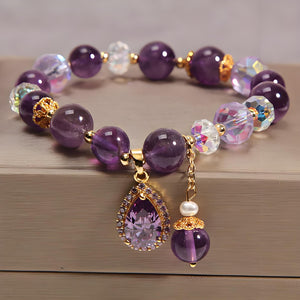
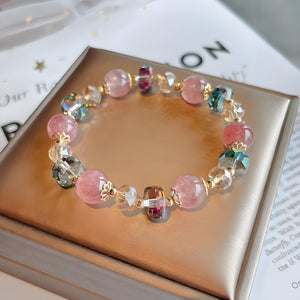





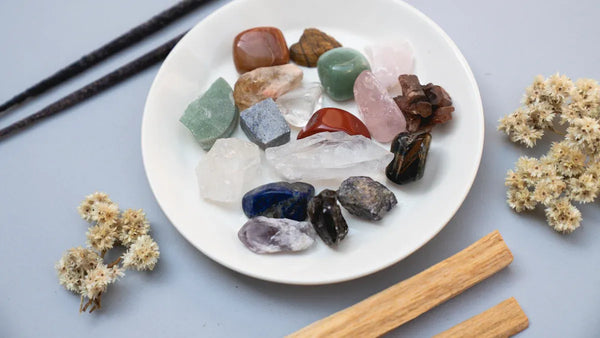
0 comments